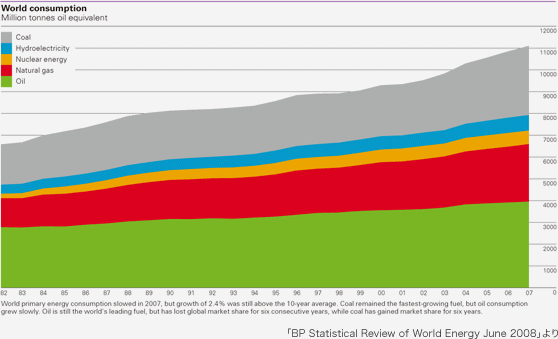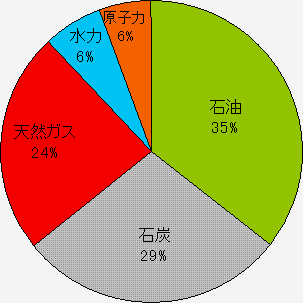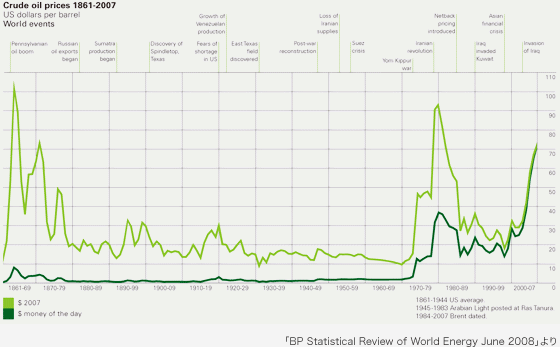代表のEcoコラム
8. エネルギー資源の不足
2008.10.15
前回のコラムでは、「エネルギー資源、水、食糧の不足」 の中の「食糧の不足」を取り上げました。今回は、「エネルギー資源の不足」 について書いておきたいと思います。
「BP Statistical Review of World Energy June 2008」よりエネルギー資源についてのデータを取り上げてみます。
● どのくらいのエネルギー資源を使っているか?
2007年には、世界で石油換算で、約111億ton ( 11,099.3百万ton) 相当のエネルギーを使った。 1997年 2007年の10年間で1.25倍になった。平均で毎年約2.2%ずつの伸び。 ただし、2002年 2007年の後半の5年間は、平均で毎年約3.1%の伸びに増加している。 石油、天然ガス、原子力、水力、石炭の中では、石炭の消費が最も大きく伸びている。2006年~2007年で4.67%の伸び。 石油の伸びは低い。2006年 2007年で1.07%の伸び。エネルギー消費の35.61%が石油によってまかなわれ、ついで石炭で28.63%である。


● あとどのくらいのエネルギー資源が残っているか?
世界のエネルギー資源確認埋蔵量は、以下のようになっています。

しかし、ここで注意が必要なのは、可採年数は 、これまではどんどん減っていくどころか歴史的には増えてきた のです。事実、1930年には、石油の可採年数は18年程度とされていたのです。それが1960年には30年になり、1990年になると45年になったのです。それは、使う量の増加よりも確認埋蔵量の増加が大きかったということだと思います。ですから必ずしもこの可採年数に近い年数で資源が枯渇してしまうとは限りません 。
近年では、石炭の需要の急拡大に伴って、石炭の可採年数は年々急速に減っている (BP統計より:2004年 192年、2006年 155年、 2008年 133年)というところは大変気になるところです。
いずれにしても、確認埋蔵量が増えていくにせよ、これまでのように簡単に安いコストで取り出せる資源はどんどん少なくなっていくと思われます。したがって、可採年数が減らない(あるいは増える)ことがあっても、やはり、長期的にはエネルギー資源はこれまでのように安くは手に入りにくくなる と思われます。
● エネルギー資源の高騰
エネルギー資源の価格については、皆さんよくご存知のように、2000年以降急激に高騰しています。 一番代表的な原油の価格の約140年に渡る推移を下記のグラフに示しています。ここで濃い緑色の線が、その時々の実際の価格を示し、黄緑の線は、その価格を現在の貨幣価値に置き換えたものをしめしています。1990年代にはほぼ1バレル20ドル以下で推移していたものが、2008年にはついに100ドルを突破 しました。世界的なエネルギー需要の増加に加えて、世界の政治的な不安定さへの懸念や投機的な資金の動きが重なってこのような状況になっているものと思われます。また長期的に見ても、上記の可採年数に関連して述べたように、化石燃料資源については1990年代のような安い値段に再び戻って落ち着く可能性はかなり低いと思われます。
先進国の人はガソリン代が上がって困っていますが、原油の値上がりは直接ガソリンなどの燃料の値上がりだけでなく、エネルギーを使って生産されるものを含めあらゆるものが影響を受けています。特に、前回取り上げた食糧の値上がりにも影響 し、これは途上国の貧しい人々をさらに危機的な状況に追いやっており 、緊急な対策と長期的な対策の両方が必要です。

さて、これまで取り上げた水、食糧に続いて、石油などのエネルギー資源は人類が生きていくのに不可欠なものになっています。しかし、現在主流に使われている化石に由来するエネルギー資源は、このままの調子で需要が続けば、いずれにしても今後100年前後で、今よりももっと希少で高価な資源になることは明らかです。CO2の発生を抑えることももちろん重要ですが 、それ以上にこのように価格が高騰していく状況に対して、いったい我々がどうするのかがより緊急で重要 だと考えます。
このエネルギー資源の不足とCO2の問題の両方の解決策となりうるものとして、原子力が従来にも増して脚光を浴びています。次回はこれに関連して、放射性物質の利用と廃棄という面で述べたいと思います。
2008年10月15日 松井 宏信


